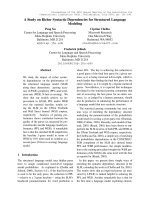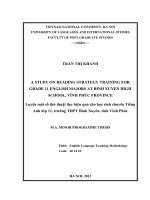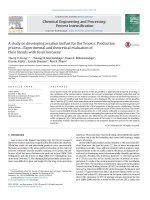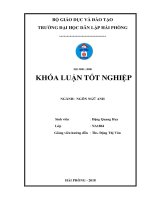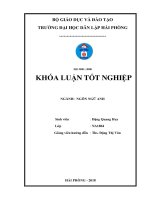A study on cassava residue preservation for dairy cattle feeding
Bạn đang xem bản rút gọn của tài liệu. Xem và tải ngay bản đầy đủ của tài liệu tại đây (48.44 KB, 7 trang )
A STUDY ON CASSAVA RESIDUE PRESERVATION FOR DAIRY CATTLE
FEEDING
Bui Quang Tuan
Hanoi Agricultural University
Abstract
Cassava residue samples were taken to determine chemical composition, HCN and
aflatoxin contents. In a laboratory experiment cassava residue was ensiled with either 0.5%
salt or 0.5% salt plus 3% molasses (on a fresh matter basis). Fermentation characteristics of
the silages were determined at 4 weeks of ensiling. Results showed that cassava residue was
very poor in CP and minerals. Sun-drying was difficult because fresh cassava residue
contained very high moisture levels (>80%). HCN content was very high in fresh cassava
residue (162.4 mg/kg), but it decreased rapidly with storing time (8.84 mg/kg after 10 days of
storage). Aflatoxin content of sun-drying cassava residue was low (33.5µg/kg). Cassava
residue ensiled with 0.5% salt had a white color and cassava residue ensiled with 0.5% salt
plus 3% molasses had a light yellow color with a pleasant smell. The pH value of the silages
was 3.9, the lactic acid content was relatively high (0.89 and 1.14%, respectively). Utilization
of ensiled cassava residue with 0.5 % salt instead of cassava meal in dairy cow’s ration as an
energy source guaranteed high milk production (17.2 kg milk/head/day), decreased feed
cost/kg milk (1,549 vs 1,805 VND/kg milk).
Introduction
Cassava (Manihot esculenta, crantz) is an important food crop for many tropical zones
in the world such as Africa, Asia and Latin America. In Vietnam it is an annual plant with the
purpose of obtaining its tuber as food and ranked as the third, food crop after the rice and
maize. In recent years when rice production has been more than enough for the domestic food
demand of the people, cassava has become a raw material as starch for the processing
industry. In the country, there have appeared many agricultural zones where cassava is planted
for starch production. The residue from the cassava starch production is by-product which may
contain 8% of starch, 15-20% of crude fibre and thus could be theoretically used as ruminant
feed. However, without immediate treatment the high water content in this product could
promote mould growth. At the same time, there exists cyanogen as a toxin retained in this byproduct. Many dairy farms have used this by-product as animal feed but there have been
several cases of intoxication which have caused considerable economic losses for the farmers.
Therefore, there is a practical need for research into processing and preserving cassava residue
to become a safe feed for ruminants.
Materials and Methods
Survey on sources of cassava residue
The potential sources of cassava residue was determined by a field survey on
traditional cassava starch production operations in Duong Lieu, Cat Que, and Lien Hiep
communes (Ha Tay province). Data were collected from production reports of the communes.
1
PDF created with pdfFactory Pro trial version www.pdffactory.com
Ensiling cassava residue
Under laboratory conditions cassava residue was ensiled in plastic vessels or chambers
for fermentation and under farm conditions in sealed nylon sacks with 2 ensilage formulae as
follows:
Formula 1: Cassava residue with 0.5% salt (on fresh basis);
Formula 2: Cassava residue with 0.5% salt plus 3% molasses (on fresh basis).
After 4 weeks of fermentation reprsentative samples were taken for assessment of color,
smell, pH, organic acids, aflatoxin and HCN contents. Determination of pH followed the
method of Hartley and Jones (1978) with 5g of sample added into 100 ml of distilled water in
a beaker which was then shaked for a while and kept during 15 minutes before measuring with
a pH meter.
Feeding trial
A feeding trial with dairy cows was carried out at dairy households in Dong Thap
commune (Dan Phuong, Ha Tay) from January to April 2005. In the dairy cow diet ensiled
cassava residue was considered as an energy source to replace cassava meal for the diet
recommended by Guyomarch company. Dairy cows were raised in 4 households with 2 cows
each. The nutrient requirements of the experimental cows were calculated following NRC
recommendations (1989). The trial lasted for 2.5 months (excluding 15 days of the adaptation
period).
Table 1. The experimental design of the feeding trial
Parameters
Control group
Exp. group
4
4
515 ± 11
518 ± 8
Lactation
2-5
2 -5
Lactation month
2-4
2-4
Milk yield before exp. (kg/head/day)
20.7 ± 0.3
21.0 ± 0.4
Grasses
Ad libitum
Ad libitum
Guyo condensed concentrate (g/kg milk)
60
60
Maize meal (g/kg milk)
160
160
Cassava meal (g/kg milk)
180
0
0
1
2.5
2.5
No of cattle (heads)
Initial weight (kg/head)
Cassava residue ensiled with 0.5% salt (kg/kg milk)
Experiment duration (months)
Chemical analysis
Chemical composition of cassava residue was determined in laboratory of the Faculty of
Animal Science and Veterinary Medicine, Hanoi Agricultural University following AOAC
(1995).
2
PDF created with pdfFactory Pro trial version www.pdffactory.com
HCN and organic acid contents in the cassava residue were analysed in laboratory of the
National Institute of Animal Husbandry;
Analysis of aflatoxin was carried out in laboratory of the Department of Animal Hygiene
of the National Institute of Veterinary Research.
Results and discussion
Potential sources of cassava residue in the study area
In the North of Vietnam prosessing cassava starch is done mainly in the villages by
artisan methods. Half of the households in the studied communes were involved in cassava
starch production. Results from the present study showed that the amount of dry cassava
starch and cassava residue from prosessing 1000 kg fresh cassava tuber were 192.1 ± 1.13 and
185.3 ± 2.92 kg, respectively. Le Viet Ly et al (2004) reported that the amounts were 200 and
180 kg, respectively. Therefore, the amount of cassava residue in the area was high.
Table 2. Cassava and arrowroot starch production in the study area
Parameters
Duong Lieu
Cat Que
Lien Hiep
Total households
2,553
2,673
2,075
Agricultural product processing households
1,800
1,500
1,200
Cassava, arrowroot starch processing households
1,400
1,200
850
Quantity of cassava starch produced (tons/year)
60,000
45,000
35,000
Quantity of arrowroot starch produced (tons/year)
20,000
10,000
5,000
Quantity of cassava residue (tons/year)
57,600
40,500
33,600
Source: Duong Lieu, Cat Que, and Lien Hiep commune production reports, 2004
In the prosessing season it was estimated that only a very small part of the total fresh
cassava residue produced was used to feed animals directly in the area, while the majority was
dried under the sun for sale.
Chemical composition of cassava tuber and cassava residue
Results of chemical analyses of cassava products and cassava residue are given in
Table 3.
Fresh cassava residue contained very high levels of water (>80%), so it was very
difficult for sun-drying and mould easily developed during sun-drying, especially the cassava
starch prosessing season is in Winter. Therefore, it is necessary to find suitable methods to
preserve cassava residue.
As can be seen, cassava tuber, cassava meal and cassava residue were rich in energy
but poor in protein. These products were also poor in minerals. Thus, attention should be
payed to protein and mineral supplements to meet the requirements of animals to be fed.
3
PDF created with pdfFactory Pro trial version www.pdffactory.com
Crude fibre of cassava residue was relatively low and it was always fine ground
(reduced rumination), whereas the diet of cattle should contain “structural fibre” to maintain
normal numination and rumen pH.
Table 3. Chemical composition of cassava products and cassava residue (% DM)
DM
(%)
Crude
protein
Lipid
Crude
fibre
NDF
Crude
ash
Ca
P
Fresh cassava tubers
40.45
3.70
0.90
3.51
5.79
3.60
0.11
0.11
Dry cassava chips
88.20
3.10
0.94
2.30
3.69
2.01
0.20
0.06
Cassava meal
88.12
3.55
0.51
2.72
5.56
2.85
0.15
0.15
Fresh cassava residue
14.35
2.02
0.55
10.52
18.60
1.88
0.27
0.06
Dry cassava residue
85.30
2.29
1.17
9.37
15.94
2.07
0.37
0.07
Material
Table 4. Contents of toxins in cassava tubers and cassava residue
pH
HCN
(mg/kg)
Aflatoxin B1
(µg/kg)
Fresh cassava root
-
200.35
-
Dry cassava residue
-
78.00
33.5
Fresh cassava residue
6.0
162.40
Negative
Cassava residue inside stock 3th day of storage
5.2
110.40
Negative
Cassava residue inside stock 7th day of storage
4.6
10.60
Negative
Cassava residue inside stock 10th day of storage
4.4
8.84
Negative
Cassava residue inside stock 60th day of storage
4.0
6.28
Negative
Cassava residue in surface of stock 10th day of storage
4.7
-
Negative
Cassava residue in surface of stock 60th day of storage
4.5
-
Negative
Cassava residue ensiled with 0.5% salt
3.9
5.20
Negative
Cassava residue ensiled with 0.5% salt plus 3% molasses
3.9
5.20
Negative
Material
The HCN content in fresh cassava tubers varied depending on cassava variety, growing
conditions, age of plant and type of soil. In a study in Central Vietnam it was found to be
about 300mg/kg DM (Loc, 1996). Owing to grinding, washing and decanting during starch
extraction, HCN is partly dissolved in the sewage and consequently the HCN content in
cassava residue is considerably lower than that in fresh cassava tubers (Ninh Thi Len, 2001).
The authour (2001) also reported that the HCN content in fresh cassava residue was only 185
mg/kg DM. In our research the HCN content in fresh cassava residue was much higher
(162.40 mg/kg) than that reported by Ninh Thi Len (2001). The HCN content in cassava
4
PDF created with pdfFactory Pro trial version www.pdffactory.com
residue was high because it is mainly concentrateed in cassava peel (outer cover) which
remains in the cassava residue after starch processing.
A high content of starch in cassava residue facilitates fermentation and on the 7th day
of storage pH value dropped to 4.6, and on the 10th day to 4.4. This condition inhibited mould
development, disintergrated HCN in cassava residue.
Aflatoxin B1 was found only in dry cassava residue but in a harmless amount (33.5
µg/kg). Due to vaporization the HCN content in dry cassava residue was also harmless for
feeding animals.
The results in Table 4 indicated that aflatoxin was not a cause of death of cattle which
were fed cassava residue. There could be 2 causes of death of cattle fed cassava residue:
- Cattle were fed fresh cassava residue. The critical amount for cattle is 2-4 mg
HCN/kg bodyweight (Makkar et al., 1991). Therefore, feeding 5-10 kg fresh cassava residue
is enough to kill a cattle. Cassava residue silage is a very safe feed for cattle.
- Using cassava residue as a main feed in the ration (due to lack of roughage in dry
season) may lead to rumen acidosis. Adding “structural fibre” like rice straw, maize stover
would help increase saliva secretion which reduces the risk of rumen acidosis.
Color and acidity of ensiled cassava residue
Cassava residue ensiled with 0.5% salt had a white color and cassava residue ensiled
with 0.5% salt plus 3% molasses had a light yellow color and a pleasant smell. The pH value
of cassava from the 2 treatments was 3.9, and the lactic acid content was relatively high (0.89
and 1.14%, respectively).
Table 5. Acidity of ensiled cassava residue
pH
Lactic
acid
(%)
Acetic
acid
(%)
Butyric
acid
(%)
Cassava residue ensiled with 0.5% salt
3.9
0.89
0.23
0.01
Cassava residue ensiled with 0.5% salt plus 3% molasses
3.9
1.14
0.13
-
Treatments
Responses of dairy cattle to feeding ensiled cassava residue
Table 6 shows results of the feeding trial using ensiled cassava residue to feed
lactating cows. Ensiled cassava residue had a pleasant smell so dairy cattle liked to eat much
(they eat all the amount provided in the ration). Because feed intake was very high and the diet
was adequately calculated, milk production of the experimental group was high. There was no
significant difference between two groups (17.2 vs 17.5 kg/head/day). Feed convertion ratio of
two groups was 0.92 and 0.94 kg DM/kg milk, respectively. Since the ensiled cassava residue
was very cheap (about 70 VND/kg) the feed cost per kg milk was lower in the experimental
group than in the control group (1,549 vs 1,805 VND/kg milk). There were no significant
difference in quality of milk between the control group and the experimental group.
5
PDF created with pdfFactory Pro trial version www.pdffactory.com
Table 6. Performance of lactating cows fed cassava residue silage
Parameters
Control group
Exp. group
Feed intake (kg DM/cow/day)
16.16
16.12
Milk production (kg/cow/day)
17.5 ± 0.4
17.2 ± 0.4
Milk fat (%)
3.83 ± 0.14
3.8 ± 0.1
Milk protein (%)
3.47 ± 0.05
3.41 ± 0.05
Lactose (%)
5.20 ± 0.01
5.17 ± 0.05
- 0.53
- 0.55
0.92
0.94
Diet cost (VND/day)
31,587
26,797
Feed cost per kg milk (VND)
1,805
1,549
Fpp
Feed conversion ratio (kg DM/kg milk)
Conclusions
- The quantity of cassava residue in the study area was large (estimated over 100,000
tons per year).
- The HCN content in fresh cassava residue was too high (162.4 mg/kg) to be directly
fed to animals.
- Cassava residue ensiled with 0.5 % salt with or without molasses had good quality
and it is safe to feed animals (the HCN content reduced to 5.2 mg/kg).
- Use of cassava residue ensiled with 0.5 % salt to replace cassava meal in a dairy cow
diet as an energy source could maintain a high milk production (17.2 kg milk/head/day) and
decreased feed cost/kg milk (1,549 vs 1,805 VND/kg milk).
Acknowledgments
The authour would like to express sincere thanks to the Norwegian Council of
Universities' Committee for Development Research and Education (NUFU) for the financial
support to the present study.
Refferences
Hartley, R.D. and E.C. Jones (1978). Effect of aqueous ammonia and other alkalis on the in – vitro
digestibility of barley straw. J. Sci. Food Agric. 29, 92 – 98.
Ninh Thi Len (2001). Evaluation of chicken manure and cassava residue as feed for fattening F1 pigs
under village conditions in North Vietnam. M.Sc. thesis. Swedish University of Agricultural
Sciences, Department of Animal Nutrition and Management, Uppsala, Sweden.
Nguyen Thi Loc (1996). Evaluation of protein supplementation of traditional diets and cassava root
silage for local crossbred pigs under village conditions in Central Vietnam. M.Sc. Thesis.
6
PDF created with pdfFactory Pro trial version www.pdffactory.com
Swedish University of Agricultural Sciences, Department of Animal Nutrition and
Management, Uppsala, Sweden.
Le Viet Ly, Le Van Lien, Bui Van Chinh, Nguyen Huu Tao (2004). Sustainable animal production
in agricultural production system chainging process. Agriculture Publishing House. Pp. 100 103.
Makkar H.P.S. (1991). Antinutritional factors in animal feedstuffs – mode of actions. Int. J. Anim.
Sci. 6. 88 – 94.
NRC (1989). Nutrient requirements of domestic animals. No. 3. Nutrient requirements of dairy cattle,
6th rev. ed., National Academy Press, Washington D.C. 1989.
7
PDF created with pdfFactory Pro trial version www.pdffactory.com

